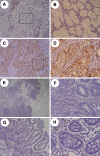Identification of transgelin as a potential novel biomarker for gastric adenocarcinoma based on proteomics technology
- PMID: 18446369
- PMCID: PMC12161733
- DOI: 10.1007/s00432-008-0398-y
Identification of transgelin as a potential novel biomarker for gastric adenocarcinoma based on proteomics technology
Abstract
Purpose: To find a biomarker for gastric adenocarcinomas (GA).
Methods: Ten protein expression profiles of GA and paired non-neoplastic mucosa tissues were analyzed by two-dimensional gel electrophoresis. Forty-two protein spots that were differentially expressed by twofold or greater between cancer and normal mucosa tissue were excised and identified by MALDI-TOF/TOF MS. One of the over-expressed proteins identified in GA was transgelin, which was chosen for further verification by immunohistochemistry and western blotting.
Results: Forty-two distinct proteins that were differentially expressed at least twofold between the tissues were identified. Expression of 29 of these proteins was decreased (ratio >or= 2, P < 0.01), including adenosine deaminase; and 13 proteins displayed over-expression in cancer tissue (ratio >or= 2, P < 0.01), including transgelin. The results of immunohistochemistry confirmed that transgelin was indeed over-expressed in 22 cases of GA (22/41, 53.66%), with strong cytoplasmic staining in cancer cells of positive samples, this was absent in most paired non-neoplastic mucosa cells or gastric ulcer tissues (n = 20). Transgelin was found over-expressed in 21 samples of cancer tissue (21/41, 51.22%) when detected by western blot.
Conclusion: This work demonstrates that differentially expressed proteins can be identified by proteomics technology combined with immunohistochemistry and western blot analyses. We have identified one such protein, transgelin, as a novel biomarker for GA.
Figures



Similar articles
-
Differential proteomic analysis of a highly metastatic variant of human breast cancer cells using two-dimensional differential gel electrophoresis.J Cancer Res Clin Oncol. 2010 Oct;136(10):1545-56. doi: 10.1007/s00432-010-0812-0. Epub 2010 Feb 14. J Cancer Res Clin Oncol. 2010. PMID: 20155427 Free PMC article.
-
Identification and verification of transthyretin as a potential biomarker for pancreatic ductal adenocarcinoma.J Cancer Res Clin Oncol. 2013 Jul;139(7):1117-27. doi: 10.1007/s00432-013-1422-4. Epub 2013 Apr 2. J Cancer Res Clin Oncol. 2013. PMID: 23546595 Free PMC article.
-
Identification of proteins associated with lymph node metastasis of gastric cancer.J Cancer Res Clin Oncol. 2014 Oct;140(10):1739-49. doi: 10.1007/s00432-014-1679-2. Epub 2014 May 15. J Cancer Res Clin Oncol. 2014. PMID: 24828259 Free PMC article.
-
Signs and symptoms to determine if a patient presenting in primary care or hospital outpatient settings has COVID-19.Cochrane Database Syst Rev. 2022 May 20;5(5):CD013665. doi: 10.1002/14651858.CD013665.pub3. Cochrane Database Syst Rev. 2022. PMID: 35593186 Free PMC article.
-
Smoking cessation medicines and e-cigarettes: a systematic review, network meta-analysis and cost-effectiveness analysis.Health Technol Assess. 2021 Oct;25(59):1-224. doi: 10.3310/hta25590. Health Technol Assess. 2021. PMID: 34668482
Cited by
-
Deoxynivalenol Affects Cell Metabolism and Increases Protein Biosynthesis in Intestinal Porcine Epithelial Cells (IPEC-J2): DON Increases Protein Biosynthesis.Toxins (Basel). 2018 Nov 9;10(11):464. doi: 10.3390/toxins10110464. Toxins (Basel). 2018. PMID: 30423940 Free PMC article.
-
Association of the actin-binding protein transgelin with lymph node metastasis in human colorectal cancer.Neoplasia. 2009 Sep;11(9):864-73. doi: 10.1593/neo.09542. Neoplasia. 2009. PMID: 19724680 Free PMC article.
-
Transgelin increases metastatic potential of colorectal cancer cells in vivo and alters expression of genes involved in cell motility.BMC Cancer. 2016 Feb 4;16:55. doi: 10.1186/s12885-016-2105-8. BMC Cancer. 2016. PMID: 26847345 Free PMC article.
-
Epidermal growth factor (EGF) and interleukin (IL)-1β synergistically promote ERK1/2-mediated invasive breast ductal cancer cell migration and invasion.Mol Cancer. 2012 Oct 21;11:79. doi: 10.1186/1476-4598-11-79. Mol Cancer. 2012. PMID: 23083134 Free PMC article.
-
Screening and identification of serum proteomic biomarkers for gastric adenocarcinoma.Exp Ther Med. 2012 Jun;3(6):1005-1009. doi: 10.3892/etm.2012.515. Epub 2012 Mar 14. Exp Ther Med. 2012. PMID: 22970007 Free PMC article.
References
-
- Aung PP, Oue N, Mitani Y et al (2006) Systematic search for gastric cancer-specific genes based on SAGE data: melanoma inhibitory activity and matrixmetalloproteinase-10 are novel prognostic factors in patients with gastric cancer. Oncogene 25:2546–2557 - PubMed
-
- Cheung PK, Woolcock B, Adomat H et al (2004) Protein profiling of microdissected prostate tissue links growth differentiation factor 15 to prostate carcinogenesis. Cancer Res 64:5929–5933 - PubMed
-
- Cho WC, Cheng CH (2007) Oncoproteomics: current trends and future perspectives. Expert Rev Proteomics 4:401–410 - PubMed
-
- Dube V, Grigull J, Desouza LV et al (2007) Verification of endometrial tissue biomarkers previously discovered using mass spectrometry-based proteomics by means of immunohistochemistry in a tissue microarray format. J Proteome Res 6:2648–2655 - PubMed
MeSH terms
Substances
LinkOut - more resources
Full Text Sources
Medical
Research Materials

